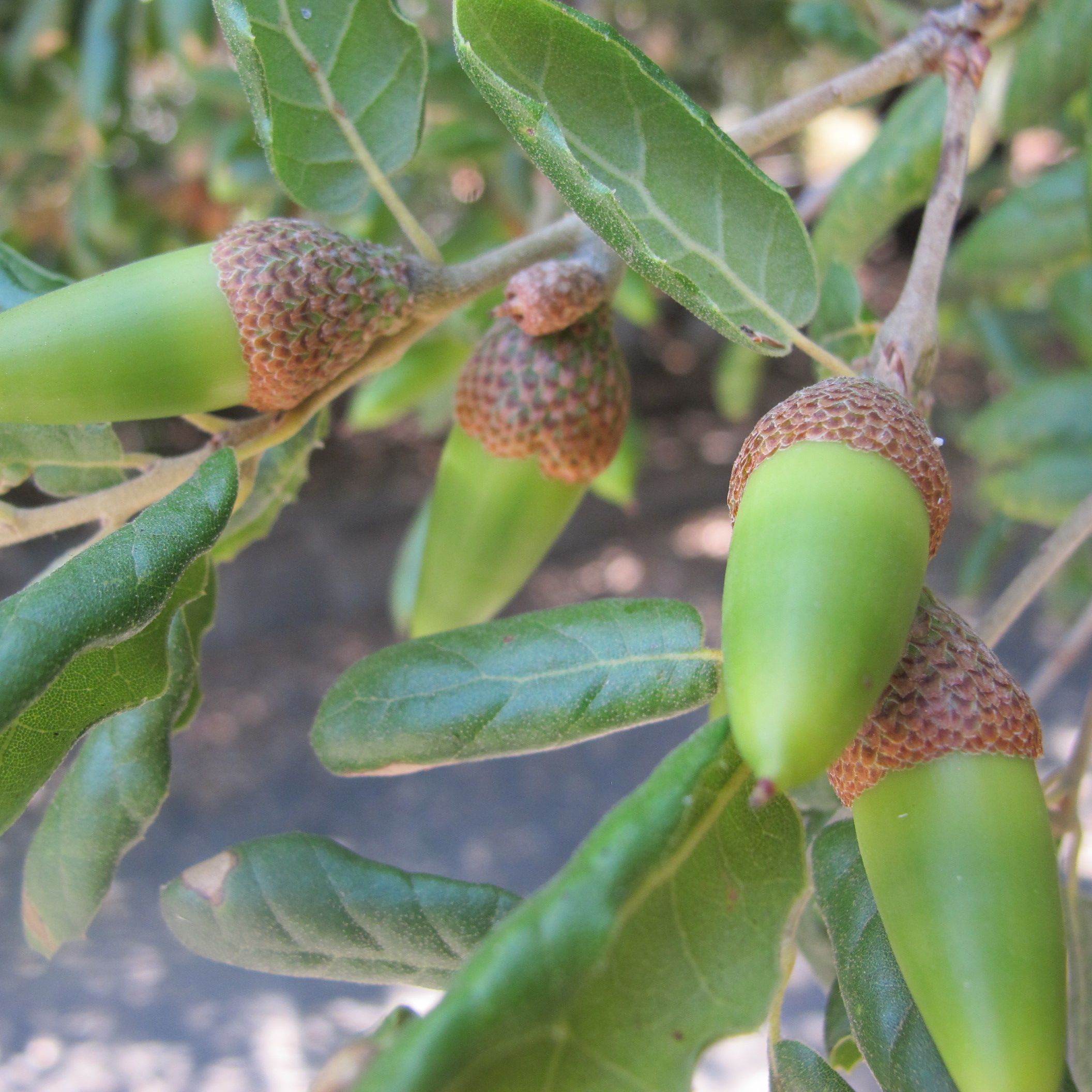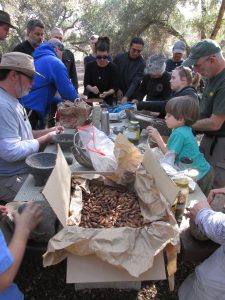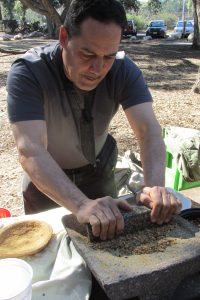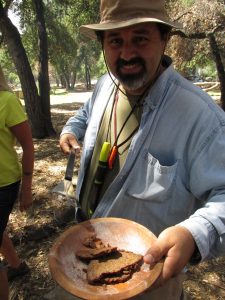ACORNS: The Breadbasket of Native California
Christopher Nyerges [www.SchoolofSelf-Reliance.com]
Every fall, generally starting in September, all of the abundant oak trees begin to drop their acorns – the nut of the oak tree – and in some years they drop in prolific volumes. The acorn has long been a wonderful source of a starchy food, especially among the native peoples of California.
According to Kathleen Rose Smith, author of “Enough For All,” “Acorn soup or mush – called tho’o – is the plant food most associated with California Indians. California Native people from every part of the state still enjoy having thick tho’o at home and during public ceremonies. .. Depending on the amount of water used, it will be thick, like a mush, and can be eaten with two fingers… or with more water added, it can be eaten like a soup.”
Another book which is devoted entirely to traditional acorn processing is “It Will Live Forever” by Bev Ortiz. This book documents how the traditional acorn processing method done by the Miwuk/ Paiute people of the Yosemite Valley. This is the book to read to grasp the great historical significance of acorns in indigenous culture.
“Acorns and Eat’Em” by Suellen Ocean contains the most acorn recipes I’ve seen in one book, with recipes for dips, pancakes, burgers, chips, pasta, and more.
The availability of acorns to California tribes was as important in their social development as was agriculture to other cultures. Acorns were a more or less guaranteed food source, and thus provided a stable foundation upon which the other aspects of the society could grow. And you didn’t just go collect acorns wherever you wanted. Families controlled the various oak groves, and thus controlled the access to the acorns, which represented political power.
Students shell and grind acorns.
Today, there are tons of acorns which drop from the thousands of oak trees throughout the San Gabriel Valley and beyond. The majority are swept up by gardeners and disposed. In the mountains, the acorn crop is nearly always more than all the animals can eat, and by my observation, approximately 85% of all acorns simply fall on the ground and decompose, and a few actually sprout. In other words, wherever you see acorns in the city, you’d be doing a service by picking some up if you want to try eating some. Always ask permission if you see them on private property. (In certain areas, like natural areas or park service areas, it is forbidden to collect acorns or other natural materials.)
You don’t just pick up acorns and eat them, as you might do with walnuts or pine nuts. Due to the presence of tannic acid, acorns must be processed to remove the tannic acid before eating.
David Martinez grinds shelled acorns into flour
Acorns were such an important food that every tribe had their own way of processing them, so there was a lot of variety in how this would have been done. There was also a lot of lore surrounding the types of acorns; the acorn meal sometimes had a religious significance and would have been used in various ceremonies, in much the way that corn or corn pollen is often used
One way to leach out the tannic acid was to shell the acorns (easier to shell when dried first), finely ground and then placed on a sloping rock with a lip at the lower end or some other variation of a colander. Cold water would be poured over the acorn meal would wash out the tannic acid. In the old days, the meal was most often used as a thickener in soups and stews, making a type of gravy.
Today, there are thousands of oak trees all throughout the San Gabriel Valley and beyond. The mountains are full of oak trees as well, and they are all starting to ripen now.
Do they taste good? Actually, even leached acorns are somewhat bland, so the flavor depends upon how they are flavored, and the recipes in which they are used.
And nutritionally, they are a literal superfood, which – according the USDA – contain all the 9 essential amino acids.
Francisco Loaiza shows freshly-made acorn pancakes.
PROCESSING
Today, on the trail or in the kitchen, the neatest and quickest way to process the acorns is to boil them and change the water repeatedly until they are no longer bitter. At that point, they are easily processed through a hand-crank meat grinder to produce a coarse meal. Ground finer, which you can do in a coffee grinder once dried, the meal is perfect for any product calling for flour. I typically mix the acorn flour 50-50 with wheat or other flours. This is partly for flavor, and partly because acorn flour doesn’t hold together as well as wheat flour, for example.
TRADITIONAL PROCESSING
The more traditional method of processing first involves shelling the acorns, and then grinding them while still raw. I typically do this on a large flat-rock metate. Then, the meal is put into some sort of primitive colander and cold water poured through it. There were many possible ways to create a colander in the old days; today, I just put a cotton cloth inside a large colander and pour warm water over the acorns. The water takes a while to trickle out, and it may require 2 or 3 or 10 pourings of water before the acorn meal is no longer bitter and can be eaten.
I have had modern acorn products of chips, pound cake, and pasta. They are delicious. If I had to describe the acorn flavor, I would say that products made with acorn flavor have a subtle graham cracker flavor.
How good are acorns for you? Here are some details from a chart that was published in Temalpakh: Cahuilla Indian Knowledge and Usage of Plants by Lowell John Bean and Katherine S. Saubel. Their source was Martin A. Baumhoff, Ecological Determinants of Aboriginal California Populations (Berkeley: University of California Press, 1936, p.162) as modified by Carl Brandt Wolf, California Wild Tree Crops (Claremont, CA: Rancho Santa Ana Botanic Garden, 1945, table 1) and Spencer, Handbook of Biological Data, W. B. Saunders Co., New York, 1956, table 156).
Chemical Composition of Hulled Acorns (in percent)
|
Species |
Water |
Protein |
Fats |
Fiber |
Carbohydrates |
Ash |
Total proteins, fats, carbohydrates |
|
Q. lobata |
9.0 |
4.9 |
5.5 |
9.5 |
69.0 |
2.1 |
79 |
|
Q. garryana |
9.0 |
3.9 |
4.5 |
12.0 |
68.9 |
1.8 |
77 |
|
Q. douglasii |
9.0 |
5.5 |
8.1 |
9.8 |
65.5 |
2.1 |
79 |
|
Q. chrysolepsis |
9.0 |
4.1 |
8.7 |
12.7 |
63.5 |
2.0 |
76 |
|
Q. agrifolia |
9.0 |
6.3 |
16.8 |
11.6 |
54.6 |
1.8 |
78 |
|
Q. kelloggii |
9.0 |
4.6 |
18.0 |
11.4 |
55.5 |
1.6 |
78 |
|
Barley |
10.1 |
8.7 |
1.9 |
5.7 |
71.0 |
2.6 |
82 |
|
Wheat |
12.5 |
12.3 |
1.8 |
2.3 |
69.4 |
1.7 |
84 |
Nutritional and Medicinal properties of ACORNS– Source USDA
Vitamins
|
Nutrient |
Amount |
DV |
|
Folate |
87.00 mcg. |
|
|
Folic acid |
0.00 mcg. |
|
|
Niacin |
1.827 mg. |
9% |
|
Pantothenic Acid |
0.715 mg. |
7% |
|
Riboflavin |
0.118 mg. |
7% |
|
Thiamin |
0.112 mg. |
7% |
|
Vitamin A |
39.0 IU |
1% |
|
Vitamin A, RAE |
2.0 mcg. |
|
|
Vitamin B12 |
0.00 mcg. |
0% |
|
Vitamin B6 |
0.528 mg. |
26% |
|
Vitamin C |
0.0 mg. |
0% |
Minerals
|
Nutrient |
Amount |
DV |
|
Calcium, Ca |
41.0 mg. |
4% |
|
Copper, Cu |
0.621 mg. |
31% |
|
Iron, Fe |
0.79 mg. |
0.79% |
|
Magnesium, Mg |
62.0 mg. |
16% |
|
Manganese, Mn |
1.337 mg. |
67% |
|
Phosphorus, P |
79.0 mg. |
8% |
|
Potassium, K |
539.0 mg. |
11% |
|
Sodium, Na |
0.0 mg. |
0% |
|
Zinc, Zn |
0.51 mg. |
3% |
|
|
|
|
This information is taken mostly from “Guide to Wild Foods and Useful Plants,” and from “Foraging California,” both by Nyerges.
BOTANY
ACORNS (Quercus sp.)
Acorns are the fruit of the oak tree. Oak trees are the Quercus species, and there are about 600 species of oak trees world-wide. In the United States, we find about 90 different species of the oak tree.
DESCRIPTION: Oak trees are very diverse, most being large trees, but some being bushes. There are species which are evergreen and those which are deciduous (they drop their leaves as winter comes). They are all recognized by their fruit, which is a nut set into a scaly cap. The acorns too are diverse in shape, some being small and narrow, others being squat and fat. Still, despite their diversity, the trees are universally recognized by their distinctive fruits, the acorns.
WHERE FOUND: These are generally native to the Northern Hemisphere, and are found throughout the world, where there is a long tradition of using the acorns for food. Nearly every state of the U.S. has at least one oak tree, and most have several. Due to their diversity, some species of the oak can be found in nearly all environments, from low to high elevations, from wet to dry.
WHEN TO HARVEST/ AVAILABILITY: The acorns begin to mature in the late September, and begin to fall from the trees. Sometimes you can harvest as early as September, but generally harvesting will occur from October through November. Once it rains or snows, the acorns will either start to mold, or sprout.
ADVICE FOR GROWING: It’s not hard to grow an oak tree. Collect an acorn when it drop, and plant it in a one gallon pot. Water it, and there’s a high chance that it will sprout. They grow somewhat slowly, and they are long-lived, and eventually you’ll want to transplant your seedling directly into the ground. You can also just plant an acorn directly int the ground in an area that you know you will want an oak tree “forever.” They can live many centuries. Select an acorn from a variety whose traits you want to have – either for the quality of the acorns, or the shade, or other factors.
RECIPES:
TONGVA MEMORIES
Process your acorn flour, and mix half-and-half with whole wheat flour. If you don’t use wheat, use another flour such as amaranth or potato flour. Add an egg if desired. Add water and mix to create a pancake batter consistency. Cook the pancakes on a buttered hot skillet, and serve with butter or jam.
CHRISTOPHER’S ACORN BREAD
1 Cup processed acorn flour
3/4 C. whole wheat flour (can substitute for a gluten-free flour, but you might need to experiment).
¼ C. carob flour
3 tsp. baking powder
1 tsp. salt. (optional)
3 Tbsp. honey
1 egg
1 cup almond milk
3 Tbsp. olive oil
Blend this together, and bake in 250 degree oven until done. This can also be cooked in a solar oven.
LINDA’S ACORN PASTA
I learned this recipe from Linda Sheer who grew up in rural Appalachia. Blend one-half processed acorn flour with one-half whole wheat flour. Add water as needed, and run it through a pasta machine, creating noodles or whatever sort of pasta you prefer. When cooked, serve with butter, or tomato sauce.
About the Author:
Nyerges has been teaching ethnobotany since 1974. He is the author of “Guide to Wild Foods and Useful Plants,” and other books on the uses of wild plants. He can be reached at www.SchoolofSelf-Reliance.com




